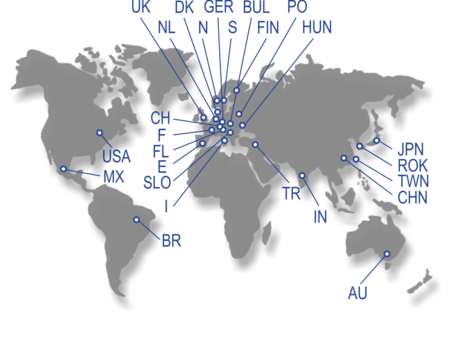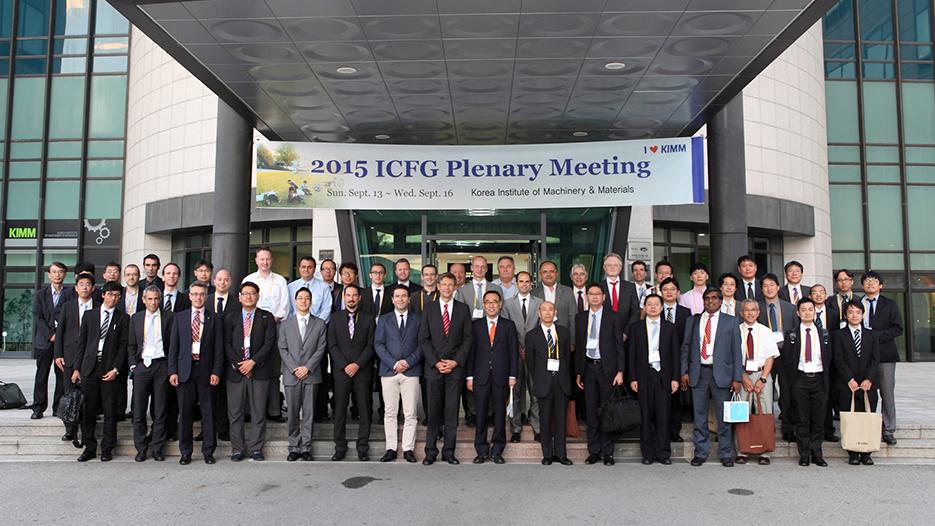The Beginning
In 1961-1967, an OECD Group of Experts in Cold Forging promoted and established international contacts and co-operations in the field of cold forging. The group consisted of Dr. H. Ll. David Pugh, Scotland, Prof. Dr. Otto Kienzle, Germany, Prof. Dr. Olof Svahn, Sweden, and other distinguished members of the Institution for Production Engineering Research (CIRP). Supported by the Organization for Economic Cooperation and Development (OECD), the Group of Experts established an international cooperative research program and prepared a survey of literature on cold forging and a dictionary. At the same time national cold forging groups had been formed in Belgium, Western Germany, the Netherlands and Sweden in addition to the already existing group. As the financial support by OECD ended, the Group decided to be able to stand on its own two feet and founded the International Cold Forging Group (ICFG) on 15 November 1967.
Table of Plenary Meetings and chairmen during the past 30 years
2016
Venue: Stuttgart, GER
Chairman: Mr. M. Yamanaka
Vice-chairman: Dr. M. Hänsel
2015
Venue: Daejeon, KOR
Chairman: Dr. M. Hänsel
Vice-chairman: Mr. M. Yamanaka
2014
Venue: Ankara, TR
Chairman: Dr. M. Hänsel
Vice-chairman: Mr. M. Yamanaka
2013
Venue: Paris, F
Chairman: Dr. M. Hänsel
Vice-chairman: Prof. A.E. Tekkaya
2012
Venue: Soenderborg, DK
Chairman: Dr. M. Hänsel
Vice-chairman: Prof. A.E. Tekkaya
2011
Venue: Soenderborg, DK
Chairman: Prof. A.E. Tekkaya
Vice-chairman: Dr. M. Hänsel
2010
Venue: Darmstadt, GER
Chairman: Prof. A.E. Tekkaya
Vice-chairman: Dr. M. Hänsel
2009
Venue: Shanghai, CN
Chairman: Prof. A.E. Tekkaya
Vice-chairman: Prof. K. Kuzman
2008
Venue: Warsaw, Pl
Chairman: Prof. A.E. Tekkaya
Vice-chairman: Prof. K. Kuzman
2007
Venue: Padova, I
Chairman: Prof. K. Kuzman
Vice-chairman: Prof. A.E. Tekkaya
2006
Venue: Changwon, ROK
Chairman: Prof. K. Kuzman
Vice-chairman: Prof. A.E. Tekkaya
2005
Venue: Chester, UK
Chairman: Prof. K. Kuzman
Vice-chairman: Dr. J. Groenbaek
2004
Venue: Istanbul, TR
Chairman: Prof. K. Kuzman
Vice-chairman: Dr. J. Groenbaek
2003
Venue: Columbus (Ohio), USA
Chairman: Dr. J. Groenbaek
Vice-chairman: Prof. K. Kuzman
2002
Venue: Helsinki, SF
Chairman: Dr. J. Groenbaek
Vice-chairman: Prof. K. Kuzman
2001
Venue: Tsukuba, JPN
Chairman: Dr. J. Groenbaek
Vice-chairman: Prof. K. Kuzman
2000
Venue: Nuremberg, GER
Chairman: Dr. J. Groenbaek
Vice-chairman: Dr. V. Maegaard
1999
Venue: Ljubljana, SLO
Chairman: Prof. M. Geiger
Vice-chairman: Prof. L. Cser
1998
Venue: Gothenburg, S
Chairman: Prof. M. Geiger
Vice-chairman: Prof. L. Cser
1997
Venue: S'Hertogenbosch, NL
Chairman: Prof. M. Geiger
Vice-chairman: Prof. L. Cser
1996
Venue: Györ, HUN
Chairman: Prof. M. Geiger
Vice-chairman: Prof. L. Cser
1995
Venue: Lyngby, DK
Chairman: Prof. N. Bay
Vice-chairman: Prof. R. Crafoord
1994
Venue: Padova, I
Chairman: Prof. N. Bay
Vice-chairman: Prof. R. Crafoord
1993
Venue: Osaka, JPN
Chairman: Prof. N. Bay
Vice-chairman: Prof. R. Crafoord
1992
Venue: Darmstadt, GER
Chairman: Prof. N. Bay
Vice-chairman: Prof. R. Crafoord
1991
Venue: Bath, UK
Chairman: Prof. R. Geiger
Vice-chairman: Ir. H.P. Pouw
1990
Venue: Imatra/Helsinki, SF
Chairman: Prof. R. Geiger
Vice-chairman: Ir. H.P. Pouw
1989
Venue: Erlangen, GER
Chairman: Prof. R. Geiger
Vice-chairman: Ir. H.P. Pouw
1988
Venue: Warsaw, PL
Chairman: Prof. R. Geiger
Vice-chairman: Ir. H.P. Pouw
1987
Venue: Warsaw, PL
Chairman: Prof. T. Wanheim
Vice-chairman: Dr. N. Bay
1986
Venue: Vaduz, FL
Chairman: Prof. T. Wanheim
Vice-chairman: Dr. N. Bay
1985
Venue: Gothenburg/Karlstad/Stockholm, S
Chairman: Prof. T. Wanheim
Vice-chairman: Dr. N. Bay
1984
Venue: Nagoya, JPN
Chairman: Prof. T. Wanheim
Vice-chairman: Dr. J. Gronbaek
1983
Venue: Tarbes, F
Chairman: Mr.T.M.B.Sessions
Vice-chairman: Dr. J. Gronbaek
1982
Venue: Lyngby/Nordborg, DK
Chairman: Mr.T.M.B.Sessions
Vice-chairman: Mr. K. Standford
1981
Venue: Birmingham, UK
Chairman: Mr.T.M.B.Sessions
Vice-chairman: Mr. R. Lawson
1980
Venue: Senlis, F
Chairman: Mr.T.M.B.Sessions
Vice-chairman: Mr. R. Lawson
1979
Venue: Stuttgart, GER
Chairman: Ir. P.I.M. Boes
Vice-chairman: Mr. R. Lawson
1978
Venue: Sunderland, UK
Chairman: Prof. K. Lange
Vice-chairman: Mr. R. Lawson
1977
Venue: Liege/Herstal, B
Chairman: Prof. K. Lange
Vice-chairman: Mr.T.M.B.Sessions
1976
Venue: Paris/Senlis, F
Chairman: Prof. K. Lange
Vice-chairman: Mr.T.M.B.Sessions
1975
Venue: Apeldoorn, NL
Chairman: Prof. K. Lange
Vice-chairman: Mr.T.M.B.Sessions
1974
Venue: Gothenburg, S
Chairman: Prof. K. Lange
Vice-chairman: Mr.T.M.B.Sessions
1973
Venue: Brno, CS
Chairman: Dr. H.Ll.D. Pugh
Vice-chairman: Mr.T.M.B.Sessions
1972
Venue: Stuttgart, GER
Chairman: Dr. H.Ll.D. Pugh
Vice-chairman: Mr.T.M.B.Sessions
1971
Venue: East Kilbride, UK
Chairman: Dr. H.Ll.D. Pugh
Vice-chairman: Mr.T.M.B.Sessions
1970
Venue: Paris, F
Chairman: Dr. H.Ll.D. Pugh
Vice-chairman: Mr.T.M.B.Sessions
1969
Venue: Paris, F
Chairman: Dr. H.Ll.D. Pugh
Vice-chairman: Mr.T.M.B.Sessions
1968
Venue: London, UK
Chairman: Dr. H.Ll.D. Pugh
Vice-chairman: Mr.T.M.B.Sessions
Introduction to Cold Forging
Cold forging is a common industrial process in which metal workpieces are plastically shaped by suitably contoured dies to form a final desired shape. The process itself is a predominantly compressive one in which the workpiece is squeezed between the dies.
Cold forging is an important process being used in many industries, for example the automotive industry in which a huge annual tonnage of cold forged components are used.
Important aspects in cold forging are: the die material and shape, the lubricant, the workpiece material, and the temperature.
Cold forging is generally understood to mean forging at room temperature or a temperature at which no microstructural changes occur as a result of the process. Warm forging is now gaining in popularity because ambient temperatures are elevated a little to decrease the required loads whilst maintaining good tolerances for the products.
Numerical analyses and simulations are now used commonly in the cold forging industry to optimize the processes and to decrease overall costs. For example in multi-step processes the number and nature of each step are very important in the cost of the finished component.
It is the objective of the ICFG to further the use of cold forging, therefore the organization is concerned with all the above variables as well as numerical analyses and simulations.
General Information
The ICFG is represented worldwide by members from industry and academia.

Objectives of ICFG
According to the preamble of the ICFG constitution, the objective of the group is to promulgate the economic advancement of cold forging
– by encouraging and co-ordinating national and international co-operation,
– by stimulating research,
– by disseminating knowledge of relevant processes and sciences.
Therefore the major part of activity concentrates on subgroup work with the aim of preparing and presenting information to the public, e.g. data sheets and guidelines.

Structure of ICFG
The ICFG consists of subgroups, each active in a particular sub-division of the main fields of interest. Each subgroup is responsible for its own program and administration, including the election of its officers. As the number of permanent members is restricted in order to maintain close personal contacts and to cut down administrative work, the subgroups are authorized to invite any person to collaborate temporarily. This regulation providing a high degree of flexibility to the subgroups has proved to be very effective. Chairman and Vice-Chairman are elected for a two year period of office and are eligible for a second term of two years. The main group consists of permanent members and assemblies annually at the Plenary Meeting to review progress, receive reports and initiate, modify or terminate subgroups activities. Of very great importance is the link between ICFG and CIRP by the double-membership of leading experts in both international institutions.